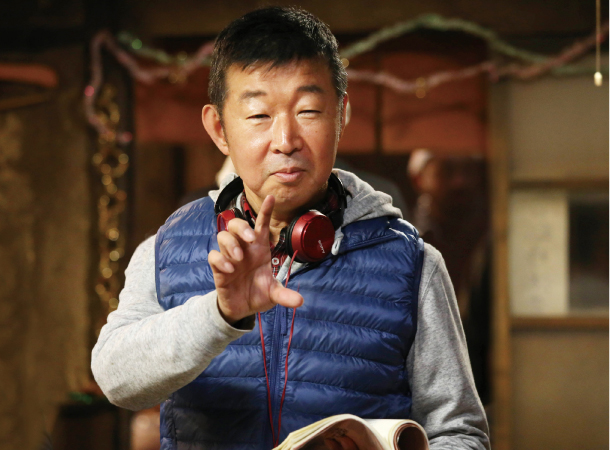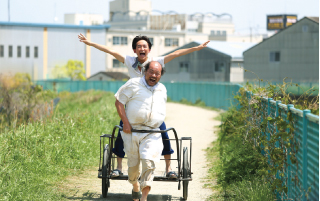‘Yakiniku Dragon’ takes us back, and to Japan: One Japanese-Korean family in Osaka in 1969 is subject of film
 사진 크게보기
사진 크게보기Director Chong Wishing said he tried to film as many scenes as possible outdoors as he made his play into a film. [FIRST RUN]Judging by its trailer, “Yakiniku Dragon” seems to be little more than just another comedy flick centered on a big family.
But the film is ultimately a bit more. It is a heart-rending tale of a Korean-Japanese family running a small restaurant named Yakiniku Dragon in a run-down area in Osaka, Japan, that’s home to many Koreans.
The film is set in around 1969.
The English title of the film is “Yakiniku Dragon” but its Korean title is “Yong-gil’s Gopchang Restaurant” to make it sound catchy in the Korean film market.
 사진 크게보기
사진 크게보기Korean-Japanese playwright and director Chong Wishing poses for a picture on the set of the film “Yakiniku Dragon.” Through the film, which recently hit local theaters, the director tells the turbulent life of Korean-Japanese people. [FIRST RUN]Gopchang is a type of Korean food made of grilled intestines.
The film is based on a play of the same title, written and directed by Korean-Japanese director Chong Wishing.
Written in 2008, the script was produced as a play the same year and won numerous awards both in Japan and Korea.
Born in Japan to a Korean father and a second-generation Korean-Japanese mother, the 63-year-old director and playwright has been telling stories of the marginalized.
These include stories of people who are on the bottom rung of society, Korean-Japanese people and those who face sexual discrimination.
But his stories on minorities were well-received in the mainstream cultural scene in Japan.
He won the Kishida Prize for best play in 1993. Chong’s scripts for the 2004 film “Blood and Bones” won him the Best Screenplay award from the Japan Academy Film Prize in 2005.
After achieving resounding success with “Yakiniku Dragon,” Chong kept himself busy writing scripts and directing other plays.
But he decided to make his play “Yakiniku Dragon” into a film in 2018, 10 years after writing the original story.
He told the local media during a press conference held as part of the 2018 Jeonju International Film Festival (JIFF), “I thought to myself that I should make this story into a film to remember it. Otherwise, it would be forgotten.”
The film was chosen as an opening film for the year’s JIFF held in the North Jeolla.
“Yakiniku Dragon” sheds a spotlight on Yong-gil (played by Kim Sang-ho) who moves to Japan after he lost an arm in World War II. He was a conscripted soldier.
He wanted to return home but couldn’t because of the April 3 uprising and massacre in his hometown on Jeju Island.
After settling down in Japan, Yong-gil happens to get married to Young-soon (played by Lee Jung-eun). They had both been married previously.
With three grown-up children from previous marriages, the two come to have a big family after having a son of their own. But the son is being bullied at school.
To make matters worse, Yong-gil is forced to leave his restaurant. Yong-gil insisted that he purchased the land on which the business sits, but the Japanese government said the land belongs to the state.
During a recent email interview with the JoongAng Ilbo, an affiliate of the Korea JoongAng Daily, Chong said the film is “half fiction and half non-fiction.”
“In fact, it’s a story of my father, not me,” said Chong.
He went on, “The rapid [economic] growth between the 1950s and the 1970s brought great prosperity to Japan. The symbol of the economic growth was the 1970 Osaka Expo and the expansion of Kansai Airport.
“A lot of Korean laborers were there to work on the expansion. They were the ones who contributed to the economic growth of Japan. In the dark shadow of prosperity, they were suffering from poverty and were discriminated against, but they lived their lives bravely. I wanted to tell their stories.”
The shantytown depicted in the film is modeled after Chong’s childhood hometown.
“It was a place where all the people who had nowhere to go got together and built their own [unlicensed] shacks along Himeji Castle. My father told me that he paid for the piece of land [where my house was built on], but it later turned out to be national land. The village has become a park, but the old town, where my father and I used to live, is still there in the film,” Chong recalled.
Since the film is an autobiographical story of the director, it is filled with anecdotes of Chong. There is this line that goes: “Korean-Japanese are contradictory. You are discriminated against and misunderstood and you hate Japan and miss Korea, but you don’t leave this country.”
Chong recalled that he grew up hearing such words very often.
But his film is not dark. The bleak reality is portrayed in humorous ways.
“That’s because I was hugely influenced by the environment where I was born and where I grew up. People were poor, but none of them were dark. They taught us how to be kind and brave.”
As the play is made into a film, audiences are not able to smell grilling barbecue as they could in the theaters, but Chong said he tried to make the best use of the new platform.
“I had only one set in the theater version of the story, but I tried to shoot as many scenes as possible outdoors in the film. The last scene was not available in the theater, but I added it for a challenge. My main focus was on how to replace things done in the theater in the film.”
For Chong, the biggest challenge was adapting the story suitable for a film. For the actors, it was the language, because about 90 percent of the lines are spoken in Japanese.
A language instructor was present on set to teach Korean actors to speak with the tones and dialects found in the Osaka region.
When asked what was it like to work with Kim for the role of Yong-gil and Lee for Young-soon, “They used to perform in plays, and they also know how to act for films. Most of all, they were the closest actors to the mother and father figures I had in my mind.”
He continued, “I never imagined a story of a Korean-Japanese family would touch the hearts of so many people. It is a story of immigrants and a story of people who lost their own land. It’s a story of people who are relocated, and it’s also a story about families. These elements could appeal to not only Koreans and Japanese, but also to people living in other parts of the world.
“Being Korean-Japanese, I’m a minority, and I’ll keep my ears open for the problems of minorities in various ways.”
In wrapping up the interview, Chong mentioned the deteriorating diplomatic relations between Korea and Japan.
“I’m so concerned that the cultural exchange between the two countries might be cut off.”
Although Chong’s newest play “Crying Romeo and Angry Juliet” has been postponed in Japan due to the outbreak of coronavirus, Chong is working on his next work, and he said one of his upcoming projects would be a film.
“If possible, I want to shoot a film in Korea. I’m in talks with producers for now. I want to deviate from my own style and do something extreme work next time.”
BY NA WON-JEONG [estyle@joongang.co.kr]
No comments:
Post a Comment